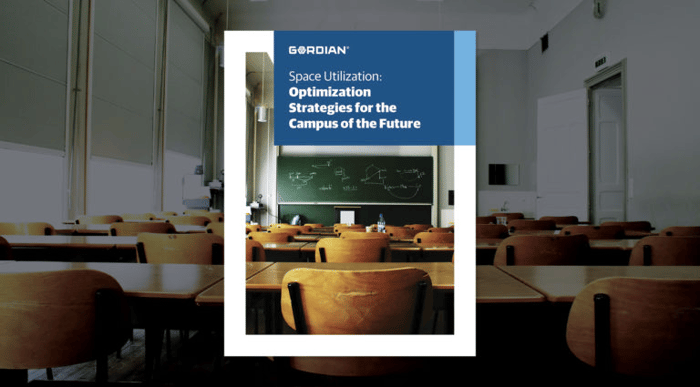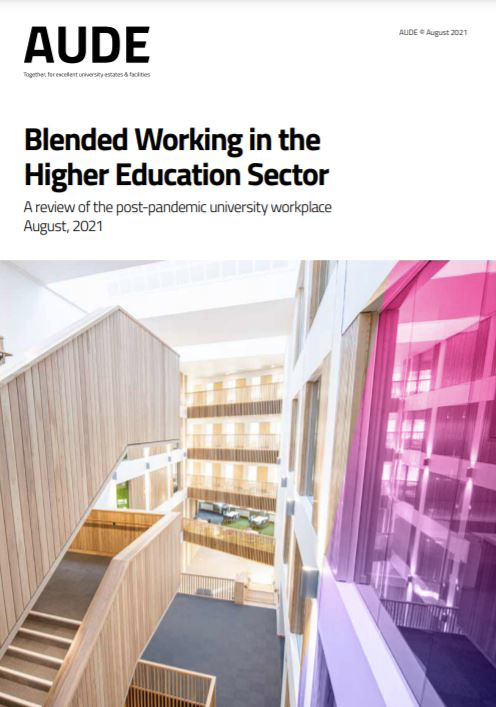What is enterprise asset management software in 2021 and beyond?

Greg Jarboe
/Adobe%20Stock%20Images/AdobeStock_94067857.jpg)
I’m pretty sure that you know what Enterprise Asset Management (EAM) software is. You may even recall what the definition of EAM software was when it first debuted back in the 1990s.
If you need a quick refresher, then I recommend reading the post by Kevin Raasch entitled, “Facilities Management Software Jargon... Simplified.” In November 2020, he said, “A more robust version of a CMMS, enterprise asset management systems offer the maintenance tracking options of a CMMS, in addition to financial, HR and administrative capabilities.”
He added, “An EAM looks at (your) whole portfolio – including physical, financial, fixed assets.”
And he concluded, “EAM is best for tracking lifetime asset performance.”
Get it? Got it? Good.
But, enterprise asset management software has evolved significantly over the past 30 years. And it’s likely to change even more as colleges and universities with complex infrastructures and changing needs struggle mightily to track their lifetime asset performance effectively in 2021 and beyond.
According to a new report from Gordian entitled, “Space Utilization: Optimization Strategies for the Campus of the Future,” facility and real estate managers at most higher education institutions are used to hearing academic department heads and administrators clamor for more space. But the pandemic’s sudden and stark disruption to “normal” operations brought a uniquely shared experience that challenged the culture of higher education as a whole.

Gordian’s report says, “Nearly every campus has seen some reduction in campus space utilization, and with the very notion of an academic community being redefined in real time, planners have begun raising questions about what kinds of classroom spaces will be needed in the future and how to optimize the physical footprint in continued service of the school’s educational mission.”
And according to “Blended Working in the Higher Education Sector: A review of the post-pandemic university workplace,” a new report by AUDE, the Association of University Directors of Estates, “The collective experience of working off campus through the COVID-19 pandemic has changed attitudes, perceptions and habits in higher education across the world.”

One of the biggest changes at Higher Education Institutions (HEIs) is the increase of “blended working,” which combines working off- and on-campus.
According to AUDE’s report, “There is a high expectation that space dividends will be gained from adopting a blended/agile work style. However this will not be realised in the immediate term. Respondents accounted the delayed implementation to staff engagement and the amount of local decisions regarding how blended/agile work styles could work for teams over the next year to inform longer-term, more coordinated projects and policies.”
Speaking on behalf of AUDE’s Space Management Group, Dave Beavis, Space Manager at the University of Exeter, said, “This report represents a timely pulse-check as to how the UK HE sector is implementing blended-working, and the survey results are striking. 89% of respondents indicated that they intend to be operating some degree of blended working practices by the end of 2022, although the rate of change to adopt these practices is likely to differ widely by institution, dictated in part by the success of any pilots and the roll out of supporting infrastructure and associated policies.”
He added, “The report identifies that most (79%) survey respondents believed they would benefit from a ‘space dividend’ after adopting blended working practices, and furthermore most intend to repurpose much of this space to an alternative use. For many institutions this will likely be student facing spaces as, overall, the survey indicated institutions believe they will require more study and social spaces, but less individual and small offices. So, blended working will provide many HEIs with the opportunity to reimagine the estate in terms of size and shape, whilst likely offering some greater degree of flexibility and resilience. It will be very interesting to see how this develops over the next few years.”
What is the best enterprise asset management software for the foreseeable future?
So, once you’ve finished with your preliminary research, which involves problem identification (“We need to do something”) and solution exploration (“What’s out there to solve our problem?”), I’m fairly confident that when you reach requirement building (“What exactly do we need our EAM software to do?”) that you’ll realize that whatever enterprise asset management software did 30 years ago isn’t “exactly” what you need to do today or in the foreseeable future.
Based on the problems that your college or university is currently trying to solve as well as the expanding set of solutions that you can consider in 2021 and beyond, you should revisit or “loop back” to make sure that you’ve identified the right problem and explored the latest solutions.
This may seem counter-productive. But, as my mother used to say, “Measure twice, cut once.” (Mom was one of the first women to become a high school shop and drafting teacher in the State of Michigan. So, she literally taught me to double-check my measurements for accuracy before cutting a piece of wood, otherwise I might have to cut again, wasting time and material.)
Then, when you begin the requirement building process, you’ll prioritize “Strategic Asset Management” instead of wasting time debating whether or not a supplier that calls your college, university, or higher education institution an “enterprise” can provide what you need.
This isn’t a distinction without a difference. There are a lot of enterprise asset management software companies that provide EAM software to other industry verticals, including: automotive and transportation; banking, energy and utilities; financial services and insurance (BFSI); government and defense; healthcare; IT and telecom; retail; as well as manufacturing. But, you need to select a supplier that understands the needs of the higher education sector.
And, essentially, what you need is to improve your strategic planning with better data that's provided by a strategic asset management solution. You need a solution that empowers your team to collect and deliver data that is accurate, complete, timely, and actionable enabling your strategic planning team to make better decisions.
This solution should have intuitive web interfaces coupled with powerful mobile applications to ensure that you collect data more efficiently than ever before while data standard enforcement guarantees it is also the best data your strategic planners have ever received.
As for requirements building, your strategic asset management solution should:
- Capture a complete asset inventory and maintain the standards and integrity of all of your asset data.
- Accurately update assessment and asset data in real time easily and on the go.
- Make better data-driven decisions for Capital Planning.
- Improve operational efficiencies and reduce admin costs.
Where can you find such an enterprise asset management software provider?
Now, several EAM software companies may provide these capabilities in the foreseeable future. But, one enterprise asset management software provider already does: AssetWorks.
AssetWorks already offers a Strategic Asset Management Solution that includes:
- AiM Assessment and Needs Analysis (ANA): Facilities Managers looking for more credible assessment data can use AiM’s ANA software, which allows them to store both asset lifecycle and deficiency data within our industry-leading IWMS platform. Quality control of their information increases, benchmarking of the information becomes possible, and the access to credible data for long-range strategic planning and budgeting becomes a reality.
- AiM AssetSync: This is a feature that allows importing and exporting asset data to and from AiM. This allows you to “bulk” load asset data into AiM, as well as to manipulate asset data outside of AiM via a standard, easy-to-use spreadsheet format.
- Go Asset Management: This provides real-time, secure access to asset data so that users can create and update asset information in the field such as replacement parts, photos, and notes. It also allows users to perform location verification, meter readings, and inspections.
- Professional Services: AssetWorks not only develops and sells the ReADY, AiM and Go software solutions, they also provide professional services and support their customers directly. With a vested interest in customer success, they partner with you in providing strategic services to meet business goals, implementation services to deploy the software and ensure adoption, custom solutions for interfacing and automation, as well as technical and support services to keep it all running smoothly.
Now, you will still want to “measure twice, cut once.” So, don’t take my word for what AssetWorks’ Strategic Asset Management Solution can do. Contact one of AssetWorks’ team of industry professionals, who average over 15 years of experience in higher education and facilities management.
But, whatever you do, do it before someone higher up expects you to find a potential space dividend after your campus adopts a blended or agile work style.
About Greg Jarboe
Greg Jarboe is the president and co-founder of SEO-PR, which has provided services to the University of the Pacific, the University of Pennsylvania, Rutgers University, and Dickinson College. Greg has been an instructor in several Rutgers Business School Mini-MBA programs.
Greg graduated from the University of Michigan, which was founded in 1817, but spent his junior year at the University of Edinburgh, which was founded in 1582, making it one of Scotland’s ancient universities and the sixth oldest university in the English-speaking world. That’s when he had his first bite of haggis at a Burns Supper.
Subscribe to AssetWorks' Blog & Newsletter
We send out periodic updates to our facilities community.
Read On

What is the best utility management software for the new normal?
A couple of years ago, selecting the best utility management software for your college or...
Learn more arrow_forward
Real Estate and Property Management Software: What Facilities Managers Need to Know
For the most part, Higher Education still takes place in physical classrooms and laboratories in...
Learn more arrow_forward.jpeg)
4 Lessons from Real On-Site Solution Assessments
Every campus tells a story, not just through its buildings, but through the people who keep those...
Learn more arrow_forward
.jpg)
